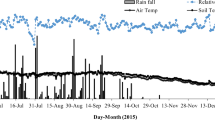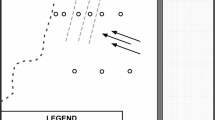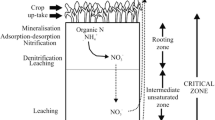Abstract
One day after application, urea-N remaining in the floodwater and determined as water-soluble N (urea-N + NH4 +-N) was used to calculate the potential N loss from lowland rice soils. Actual N loss calculated from 15N balance measurements using forced air exchange (airflow rate: 20 L min-1) in greenhouse pots. Conditions for variable potential N loss were created by manipulating the method of urea application and duration of presubmergence or by selecting soils with diverse cation exchange capacities (CEC). Potential N loss tended to be lower than actual N loss; the differences were, however, nonsignificant. The method of urea application that led to the lowest potential N loss from a Guthrie silty clay loam (Typic Fragiaquult) also led to the least 15N loss and vice-versa (r=0.99**). Duration of presubmergence did not alter the relationship between potential and actual N loss although it influenced the rate of urea hydrolysis in floodwater. The primary depencence of actual N loss on water-soluble N was maintained in soils differing in CEC (r=0.83**). The association between potential and actual N loss was closer for high-CEC soils (≥ 20 cmol [+] kg-1 soil, r=0.91**) than for low-CEC soils (<20 cmol [+] kg-1 soil, r=0.85**). Ammonia volatilization could be more closely predicted by potential N loss than could apparent denitrification.
The results of this study suggest that potential N loss calculated from one-time determination of water-soluble N in floodwater can be a good index of actual N loss from flooded, puddled rice soils. Notable exceptions are to be expected for soils in which water-soluble N gets lost from floodwater either before (soils with fast urea hydrolysis in floodwater) or after (soils with steady leaching) determination of potential N loss.
Similar content being viewed by others
References
Bouldin D R and Alimagno B V 1976 NH3 volatilization losses from IRRI paddies following broadcast, applications of fertilizer nitrogen. Internal report, IRRI, Manila, Philippines.
Buresh R J and Austin E R 1986 Measurement of denitrification in flooded rice fields. Agron. Abstr.
Buresh R J, Austin E R and Craswell E T 1982 Analytical methods in 15N research. Fert. Res. 3, 37–62.
Cao Zhi-Hong, De Datta S K and Fillery I R P 1983 Effect of placement methods on floodwater properties and recovery of applied nitrogen (15N-labeled urea) in wetland rice. Soil Sci. Soc. Am. J. 48, 196–203.
Craswell E T, De Datta S K, Obcemea W N and Hartantyo M 1981 Time and mode of nitrogen fertilizer application to tropical wetland rice. Fert. Res. 2, 247–259.
Craswell E T, De Datta S K, Weeraratne C S and Vlek P L G 1984 Fate and efficiency of nitrogen fertilizers applied to wetland rice. 1. The Philippines. Fert. Res. 6, 49–63.
De Datta S K 1981 Principles and Practices of Rice Production. John Wiley and Sons, New York, NY, 618 p.
De Datta S K and PatrickJr W H 1986 Nitrogen Economy of flooded Rice Soils. Martinus Nijhoff Publishers. Dordrecht, The Netherlands, 186 p.
Denmead O T, Freney J R, and Simpson J R 1982 Dynamics of ammonia volatilization during furrow irrigation of maize. Soil Sci. Soc. Am. J. 46, 149–155.
Denmead O T, Simpson J R and Frency J R 1977 The direct field measurement of ammonia emission after injection of anhydrous ammonia. Soil Sci. Soc. Am. J. 41, 1001–1004.
Fenn L B and Kissel D E 1976 The influence of cation exchange capacity and depth of incorporation on ammonia volatilization from ammonia compounds applied to calcareous soils. Soil Sci. Soc. Am. J. 40, 394–397.
Fillery I R P, Simpson J R and De Datta S K 1984 Influence of field environment and fertilizer management on ammonia loss from flooded rice. Soil Sci. Soc. Am. J. 48, 914–920.
Fillery I R P and Vlek P L G 1986 Reappraisal of the significance of ammonia volatilization as an N loss mechanism in flooded rice fields. Fert. Res. 9, 79–98.
Freney J R, Denmead O T, Watanabe I and Craswell E T 1980 Ammonia and nitrous oxide losses following applications of ammonium sulfate to flooded rice. Aust. J. Agric. Res. 32, 37–45.
Freney J R, Leuning R, Simpson J R, Denmead O T and Muirhead W A 1985 Estimating ammonia volatilization from flooded rice yields by simplified techniques. Soil Sci. Soc. Am. J. 49, 1049–1054.
Katyal J C and Carter M F 1989 Effect of airflow rate, leaching, and presubmergence on ammonia volatilization and denitrification loss of N from a submerged soil. Soil Sci. In press.
Katyal J C, Singh Bijay, Sharma V K and Craswell E T 1985 Efficiency of some modified urea fertilizers for wetland rice grown on a permeable soil. Fert. Res. 8, 137–146.
Lastigzon J 1981 World fertilizer progress into the 1980s. Tech. Bull. T22, International Fertilizer Development Center, Muscle Shoals, AL.
Marsh W H, Fingerhut B and Miller H 1965 Automated and manual direct methods for the determination of blood urea. J. Clin. Chem. 11, 624–627.
Reddy K R and Patrick W HJr. 1986 Fate of fertilizer nitrogen in the rice root zone. Soil Sci. Soc. Am. J. 50, 649–651.
Reddy K R, Patrick W HJr. and Phillips R E 1976 Ammonium diffusion as a factor in nitrogen loss from flooded soils. Soil Sci. Soc. Am. J. 40, 528–533.
Tellow J A and Wilson A L 1964 An absorptiometric method for determining ammonia in boiler feedwater. Analyst 89, 435–465.
Vlek P L G and Byrnes B H 1986 The efficiency and loss of fertilizer N in lowland rice. Fert. Res. 9, 131–147.
Vlek P L G and Craswell E T 1979 Effect of nitrogen source and management on ammonia volatilization losses from flooded rice soil system. Soil Si. Soc. Am. J. 43, 352–358.
Vlek P L G, Stumpe J M and Byrnes B H 1980 Urease activity and inhibition in flooded soil systems. Fert. Res. 1, 191–202.
Author information
Authors and Affiliations
Rights and permissions
About this article
Cite this article
Katyal, J.C., Gadalla, A.M. Fate of urea-N in floodwater. Plant Soil 121, 21–30 (1990). https://doi.org/10.1007/BF00013093
Received:
Issue Date:
DOI: https://doi.org/10.1007/BF00013093




